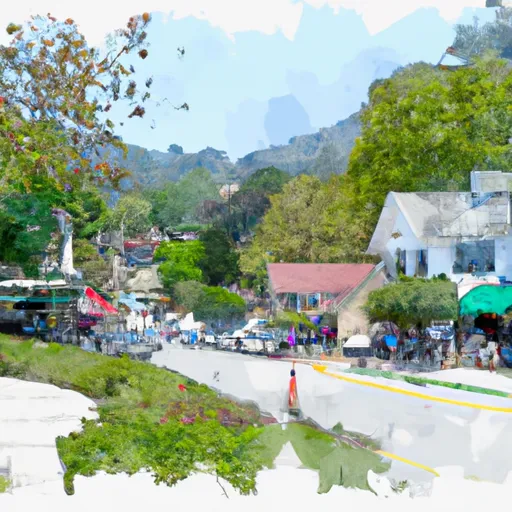-
 Snoflo Premium
Snoflo Premium
Get unlimited access to all our content
With no Ad interruptions! - Start Your Free Trial Login with existing account
Mill-Valley
Eden Index
Climate
8.3
•
Recreation
6.3
•
Community
8.7
•
Safeguard
7.7/10

Mill Valley is a picturesque town located in Marin County, California. Its climate is typically mild and Mediterranean, with warm, dry summers and cool, wet winters. Average temperatures range from 50°F (10°C) in winter to 80°F (27°C) in summer. The region is influenced by the coastal fog that rolls in from the nearby Pacific Ocean, providing a pleasant, temperate climate throughout the year.
Hydrologically, Mill Valley is surrounded by the beauty of Mount Tamalpais and the Marin Hills, which contribute to the area's unique ecosystem. The town is nestled in the Redwood Creek watershed, which flows through its heart. The creek is home to various aquatic species and serves as a vital water source for the region.
Mill Valley offers numerous outdoor recreation opportunities due to its stunning natural surroundings. Mount Tamalpais State Park provides ample hiking and biking trails, offering breathtaking views of San Francisco Bay. The Muir Woods National Monument, known for its ancient redwood trees, is just a short drive away. Residents and visitors can also enjoy water activities like kayaking, paddleboarding, and boating in Richardson Bay or nearby Stinson Beach.
Overall, Mill Valley's climate, hydrology, and outdoor recreational opportunities make it an ideal destination for nature enthusiasts and those seeking an active lifestyle amidst stunning natural beauty.
What is the Eden Index?
The Snoflo Eden Index serves as a comprehensive rating system for regions, evaluating their desirability through a holistic assessment of climate health, outdoor recreation opportunities, and natural disaster risk, acknowledging the profound impact of these factors on livability and well-being.
Climate Health Indicator (CHI): 8.3
Mill-Valley receives approximately
877mm of rain per year,
with humidity levels near 87%
and air temperatures averaging around
15°C.
Mill-Valley has a plant hardyness factor of
10, meaning
plants and agriculture in this region tend to thrive here all year round.
By considering the ideal temperature range, reliable water supplies, clean air, and stable seasonal rain or snowpacks, the Climate Health Indicator (CHI) underscores the significance of a healthy climate as the foundation for quality living.
A healthy climate is paramount for ensuring a high quality of life and livability in a region, fostering both physical well-being and environmental harmony. This can be characterized by ideal temperatures, reliable access to water supplies, clean air, and consistent seasonal rain or snowpacks.
Weather Forecast
Streamflow Conditions
San Francisco Bay
Area Rivers
San Francisco Bay
Snowpack Depths
San Francisco Bay
Reservoir Storage Capacity
San Francisco Bay
Groundwater Levels
Recreational Opportunity Index (ROI): 6.3
The Recreational Opportunity Index (ROI) recognizes the value of outdoor recreational options, such as parks, hiking trails, camping sites, and fishing spots, while acknowledging that climate plays a pivotal role in ensuring the comfort and consistency of these experiences.
Access to outdoor recreational opportunities, encompassing activities such as parks, hiking, camping, and fishing, is crucial for overall well-being, and the climate plays a pivotal role in enabling and enhancing these experiences, ensuring that individuals can engage in nature-based activities comfortably and consistently.
Camping Areas
| Campground | Campsites | Reservations | Toilets | Showers | Elevation |
|---|---|---|---|---|---|
| China Camp State Park | None | 222 ft |
Nearby Fishing
Catastrophe Safeguard Index (CSI):
The Catastrophe Safeguard Index (CSI) recognizes that natural disaster risk, encompassing floods, fires, hurricanes, and tornadoes, can drastically affect safety and the overall appeal of an area.
The level of natural disaster risk in a region significantly affects safety and the overall livability, with climate change amplifying these risks by potentially increasing the frequency and intensity of events like floods, fires, hurricanes, and tornadoes, thereby posing substantial challenges to community resilience and well-being.
Community Resilience Indicator (CRI): 8.7
The Community Resilience Indicator (CRI) recognizes that education, healthcare, and socioeconomics are crucial to the well-being of a region. The CRI acknowledges the profound impact of these elements on residents' overall quality of life. By evaluating educational resources, healthcare accessibility, and economic inclusivity, the index captures the essential aspects that contribute to a thriving community, fostering resident satisfaction, equity, and social cohesion.

